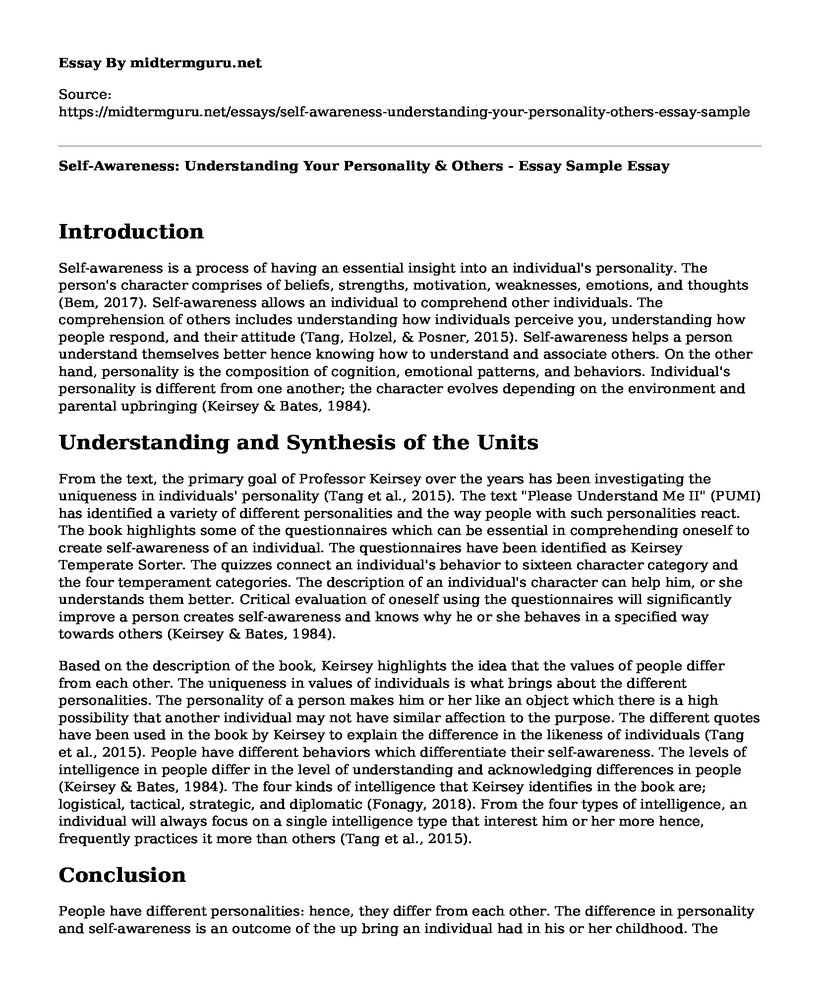Introduction
Self-awareness is a process of having an essential insight into an individual's personality. The person's character comprises of beliefs, strengths, motivation, weaknesses, emotions, and thoughts (Bem, 2017). Self-awareness allows an individual to comprehend other individuals. The comprehension of others includes understanding how individuals perceive you, understanding how people respond, and their attitude (Tang, Holzel, & Posner, 2015). Self-awareness helps a person understand themselves better hence knowing how to understand and associate others. On the other hand, personality is the composition of cognition, emotional patterns, and behaviors. Individual's personality is different from one another; the character evolves depending on the environment and parental upbringing (Keirsey & Bates, 1984).
Understanding and Synthesis of the Units
From the text, the primary goal of Professor Keirsey over the years has been investigating the uniqueness in individuals' personality (Tang et al., 2015). The text "Please Understand Me II" (PUMI) has identified a variety of different personalities and the way people with such personalities react. The book highlights some of the questionnaires which can be essential in comprehending oneself to create self-awareness of an individual. The questionnaires have been identified as Keirsey Temperate Sorter. The quizzes connect an individual's behavior to sixteen character category and the four temperament categories. The description of an individual's character can help him, or she understands them better. Critical evaluation of oneself using the questionnaires will significantly improve a person creates self-awareness and knows why he or she behaves in a specified way towards others (Keirsey & Bates, 1984).
Based on the description of the book, Keirsey highlights the idea that the values of people differ from each other. The uniqueness in values of individuals is what brings about the different personalities. The personality of a person makes him or her like an object which there is a high possibility that another individual may not have similar affection to the purpose. The different quotes have been used in the book by Keirsey to explain the difference in the likeness of individuals (Tang et al., 2015). People have different behaviors which differentiate their self-awareness. The levels of intelligence in people differ in the level of understanding and acknowledging differences in people (Keirsey & Bates, 1984). The four kinds of intelligence that Keirsey identifies in the book are; logistical, tactical, strategic, and diplomatic (Fonagy, 2018). From the four types of intelligence, an individual will always focus on a single intelligence type that interest him or her more hence, frequently practices it more than others (Tang et al., 2015).
Conclusion
People have different personalities: hence, they differ from each other. The difference in personality and self-awareness is an outcome of the up bring an individual had in his or her childhood. The environment an individual has grown in also affects their personality. Self-awareness involves knowing the inner self of a person. The ability to understand people helps a person associate with others with ease. Keirsey has discussed the numerous personality traits and the intelligence types that individuals have. Personalities are often unique from one another. To understand another person, an individual needs to try and understand their personality and preference.
References
Bem, D. J. (2017). An experimental analysis of self-persuasion. In Attitude Change (pp. 177-204). Routledge. https://www.google.com/url?sa=t&source=web&rct=j&url=https://www.academia.edu/33983725/An_experimental_analysis_of_self-persuasion&ved=2ahUKEwjazJudn43kAhXkuXEKHUJ2CioQFjAGegQIARAB&usg=AOvVaw3uLspIhpnn_JPl_xUvAxod
Fonagy, P. (2018). Affect regulation, mentalization, and the development of the self. Routledge. https://www.google.com/url?sa=t&source=web&rct=j&url=https://www.amazon.com/Affect-Regulation-Mentalization-Development-Self-ebook/dp/B07CMHF77V&ved=2ahUKEwjv76nAo43kAhVrTRUIHbstBzsQFjACegQIBxAG&usg=AOvVaw26-W7KVQqPJ-TeiN53spd7
Keirsey, D., & Bates, M. M. (1984). Please Understand Me. Temperament Character Intelligence. Prometheus Nemesis. https://cmc.marmot.org/Record/.b30725422
Tang, Y. Y., Holzel, B. K., & Posner, M. I. (2015). The neuroscience of mindfulness meditation. Nature Reviews Neuroscience, 16(4), 213. https://www.google.com/url?sa=t&source=web&rct=j&url=https://www.nature.com/articles/nrn3916&ved=2ahUKEwiup7Lmn43kAhWhQhUIHQq3A2gQFjACegQICRAB&usg=AOvVaw35CsJXCAPVL0bIg1oxKHNk
Cite this page
Self-Awareness: Understanding Your Personality & Others - Essay Sample. (2023, Feb 05). Retrieved from https://midtermguru.com/essays/self-awareness-understanding-your-personality-others-essay-sample
If you are the original author of this essay and no longer wish to have it published on the midtermguru.com website, please click below to request its removal:
- Annotated Bibliography on Treatment of Post-Traumatic Stress Disorder - Paper Example
- Paper Example on Crisis and Trauma Counseling on Domestic Violence
- Motivating E-Learners: Tips & Strategies for Success - Essay Sample
- Male Superiority and Inferior Races: A Subjugated Reality - Essay Sample
- Creating a Safe & Supportive Environment for Children's Growth & Development - Essay Sample
- Developing Personal Qualities: Initiating Communication & Relationship Management - Essay Sample
- Daycare Center Impacts Children's Development: Observations - Research Paper







